Lynton & Lynmouth Cliff Railway


Lynton & Lynmouth Cliff Railway
(1890-present)
place and cliff railway (from 1890)
Aged 135
Wikidata WikipediaThe Lynton and Lynmouth Cliff Railway is a water-powered funicular railway joining the twin towns of Lynton and Lynmouth on the rugged coast of North Devon in southwest England.Lynton and Lynmouth are separated by a high cliff, making it hard for people and goods to move between them. In the late 1800s, interest arose in building a funicular or cliff lift to join them. The civil engineer George Croydon Marks played a key role in both its design and bringing in financing from his business partner, Sir George Newnes. Local contractor Robert Jones was involved in designing the funicular's innovative braking system and the line's construction and maintenance in the first decades of its operation.In 1887, construction commenced and a year later, an Act of Parliament authorised the Lynmouth & Lynton Lift Company to operate it. The completed railway was opened on Easter Monday 1890; it has been in continuous use since. While early use was largely focused on moving freight, the funicular railway became popular with tourists and it became mostly used for passenger travel. Its flat platforms were converted into passenger carriages in 1947. It is the world's highest and steepest water-powered cliff railway in operation.
Commemorated on 6 plaques
Lynton & Lynmouth Cliff Railway Opened 1890 This Victorian funicular is the UK's only fully water powered railway and one of only three worldwide
Lynton Village Station - Lynton & Lynmouth Cliff Railway, Lynton, United Kingdom where it sited (1890)
Engineering Heritage Award The Lynton & Lynmouth Cliff Railway The oldest total loss water powered funicular railway in the UK. Designed by George Marks, it has been in continuous operation since 1890. Using the potential energy of water from the West Lyn River and incorporating innovation such as a 'Dead Man's Handle' and fail-safe braking, the railway is an integral part of the local company.
Lynton Village Station - Lynton & Lynmouth Cliff Railway, Lynton, United Kingdom where it sited (1890)
To commemorate the visit of HRH The Princess Royal to The Lynton and Lynmouth Cliff Railway on 17th April 2015 to celebrate 125 years of continuous operations
Lynton Village Station - Lynton & Lynmouth Cliff Railway, Lynton, United Kingdom where it sited (1890)
Lynton & Lynmouth Cliff Railway Opened 1890 This Victorian funicular is the UK's only fully water powered railway and one of only three worldwide
Lynmouth Bay Station - Lynton & Lynmouth Cliff Railway, Lynmouth, United Kingdom where it sited (1890)
Engineering Heritage Award The Lynton & Lynmouth Cliff Railway The oldest total loss water powered funicular railway in the UK. Designed by George Marks, it has been in continuous operation since 1890. Using the potential energy of water from the West Lyn River and incorporating innovation such as a 'Dead Man's Handle' and fail-safe braking, the railway is an integral part of the local company.
Lynmouth Bay Station - Lynton & Lynmouth Cliff Railway, Lynmouth, United Kingdom where it sited (1890)
To commemorate the visit of HRH The Princess Royal to The Lynton and Lynmouth Cliff Railway on 17th April 2015 to celebrate 125 years of continuous operations
Lynmouth Bay Station - Lynton & Lynmouth Cliff Railway, Lynmouth, United Kingdom where it sited (1890)






